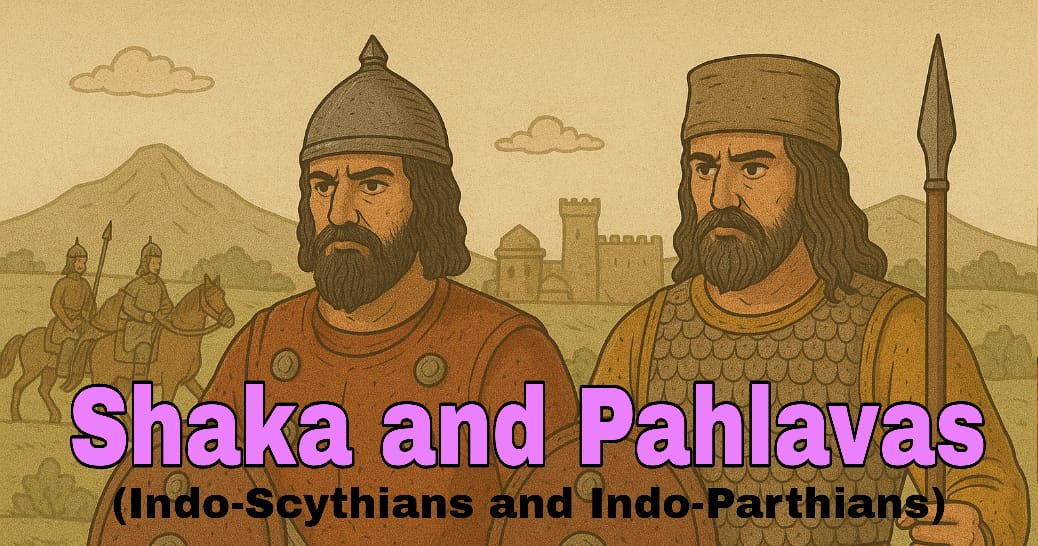Shakas and Pahlavas (Indo-Scythians and Indo-Parthians)
The Shakas (also known as Scythians) and Pahlavas (Parthians) were among the most significant foreign groups to invade and settle in ancient India after the decline of the Mauryan Empire. Originally nomadic tribes from Central Asia, they migrated into India as part of a larger wave of invasions triggered by internal pressures and external threats such as the movement of other Central Asian tribes like the Yuezhis. These groups played a pivotal role in shaping the socio-political and cultural landscape of early historic India, particularly in the northwestern regions.
The Shakas and Pahlavas are classified among the Indo-Iranian tribes and were part of the so-called “Five Indo-Scythian Hordes” mentioned in ancient Indian literature and inscriptions. They succeeded the Indo-Greeks and gradually carved out powerful kingdoms in western and central India, ruling significant parts of Gujarat, Rajasthan, Malwa, Maharashtra, and northwestern territories.
Although initially viewed as foreign invaders, the Shakas and Pahlavas eventually assimilated into the Indian cultural milieu. They adopted Indian religions such as Buddhism and Hinduism, patronized Sanskrit and Prakrit literature, and contributed significantly to art and architecture. Their rule marked a transitional phase in Indian history, linking the ancient period of Mauryan imperialism with the classical age of the Guptas.
Their coins, inscriptions, and architectural remains provide crucial evidence about the political fragmentation of post-Mauryan India, the flourishing of trade routes like the Uttarapatha and Dakshinapatha, and the interaction between Indian and Central Asian cultures. The reigns of notable rulers like Rudradaman I (Shaka) and Gondophernes (Pahlava) also reflect how these so-called ‘foreigners’ contributed richly to the regional polity, economy, and religious developments.
Thus, the history of the Shakas and Pahlavas is not merely a tale of invasion, but also of cultural synthesis, political integration, and regional consolidation that significantly impacted the subcontinent’s civilizational development.
Time Period: Mainly between 1st century BCE to 4th century CE
Origin: Nomadic tribes from Central Asia, mainly the Scythian and Parthian regions
Shakas (Scythians in Indian Context)
The Shakas, also known as the Scythians, were originally a nomadic tribe from Central Asia, especially from the region north of the Syr Darya River (also called the Jaxartes River). They are mentioned in Chinese sources as Sai or Sai-Wang, and in Indian texts, their homeland is referred to as “Shaka-sthana” or “Shaka-dvipa.”
- The Shakas are mentioned in ancient Indian texts such as:
- Ramayana and Mahabharata
- Puranas
- Patanjali’s Mahabhashya
- Gargi Samhita by Katyayana
- Harshacharita (by Banabhatta) and Kavya Mimamsa by Rajashekhara
- According to Gargi Samhita, the Shakas invaded India after the Yavana (Greek) invasions and took control of Mathura.
- As per Chinese sources like Hsien-han-shu (by Pan-ku) and Hou-Han-Shu, the Shakas were displaced by the Yuezhi (a Central Asian tribe from Mongolia).
- Initially, the Shakas invaded and captured Bactria after defeating the Indo-Greeks (Yavanas), but they were again chased by the Yuezhi, leading to their division into two branches:
- Eastern Branch: Moved south and occupied Kapisa (region between Hindukush Mountains and Kabul River, modern-day Afghanistan).
- Western Branch: Migrated westwards into Iran.
Later, the Iranian branch of the Shakas launched a major invasion into northwestern India, where they:
- Defeated the Indo-Greek (Yavana) rulers
- Established their political control in multiple regions including Takshashila (Taxila), Mathura, Ujjain, and western India.
- The Shakas followed the Persian system of provincial administration.
- Their empire was divided into provinces ruled by governors, known as:
- Kshatrapas (viceroys or provincial rulers)
- Mahakshatrapas (great satraps or senior governors)
- These Kshatrapas often became independent rulers and issued their own coins.
- Kusulaka and Patika: Ruled in northwestern India (Takshashila region)
- Rajuvula (Rajul) and Shodasa: Ruled in Mathura
- Bhumaka and Nahapana: Belonged to the Kshaharata dynasty of Maharashtra
- Chashtana and Rudradaman I: Belonged to the Kardamaka dynasty of Ujjain (Saurashtra and Malwa)
Shakas of Takshashila (Taxila) – 22 BCE to 44 CE
- Considered the first prominent Shaka ruler of India.
- He established his authority over Takshashila and defeated the Yavana rulers.
- Maues issued bilingual coins in Greek and Kharosthi, indicating both Greek influence and Indian assimilation.
- Azes I (sometimes confused with Maues) continued the expansion.
- Azes II is regarded as the last Shaka ruler of Takshashila.
- Their coins show control extended from Takshashila to Mathura.
- Fryotes, a Parthian (Pahlava) ruler, captured Taxila from the Shakas.
- Later, Gondophernes, a more powerful Indo-Parthian ruler, defeated Fryotes and took control of the region.
- The Takht-i-Bahi inscription of Gondophernes confirms his rule over northwestern India.
Shakas of Mathura
- The first Shaka ruler of Mathura was Rajuvula (or Rajul).
- A lion capital inscription from Mathura mentions Rajuvula’s chief queen (Mahishi), showing royal patronage.
- Rajuvula’s coins suggest his rule extended from eastern Punjab to Mathura.
- As per the Jain text Kalakacharya Kathanaka, the ruler of Malwa, Vikramaditya, defeated the Shakas and expelled them from Malwa in 57 BCE.
- To commemorate his victory, Vikram Samvat (Indian calendar) was started in 57 BCE.
- This era is also known as Malava Samvat or Krita Samvat.
- Shodasa, the son or successor of Rajuvula, ruled only Mathura.
- Later, Mathura came under Kushana control, and the Shaka Kshatrapas became subordinate rulers under the Kushanas.
Shakas of Western India
Two major Shaka dynasties ruled in Western India:
(A) The Kshaharata Dynasty of the Shakas
- Founder: Bhumaka
- Capital: Minnagara (in Bharuch/Gujarat region)
- This dynasty ruled over Maharashtra, Saurashtra, and Lata (southern Gujarat).
- No inscriptions found, but coins in Brahmi and Kharosthi scripts help us understand their rule.
- The use of Kharosthi script indicates influence or control over parts of Sindh and Western Rajasthan.
- Reign: Approx. 119 CE – 125 CE
- He issued a large number of silver coins.
- Title: “Ranak Kshatrapa”
- Conquered large areas from the Satavahanas, including Nasik and Pune.
- Coin evidence shows his rule from Ajmer to Nasik.
- He protected the Uttamabhadra tribe in Rajasthan from the Malavas.
- Made donations at Pushkar Tirtha (a sacred place in Rajasthan).
- Important inscriptions include:
- Nasik and Junnar cave inscriptions.
- Inscription by his son-in-law Rishabhadatta (Usavadatta) in Nasik cave.
- Ultimately defeated by Gautamiputra Satakarni of the Satavahanas.
- Many of Nahapana’s coins were overstruck and reissued by Gautamiputra with his own name — a symbol of political dominance.
- The Nasik inscription refers to Gautamiputra as “Kshaharata-vansha-nirvisheshakaraka” (one who destroyed the Kshaharata dynasty).
Administrative System of the Shakas
The Shakas followed the Persian system of provincial administration, where local hereditary rulers, known as Kshatrapas (governors), ruled provinces on behalf of the king.
- Kusulaka and Patika (Northwest India)
- Rajuvula (Rajbul) and Shodasa (Mathura)
- Bhumaka and Nahapana (Kshaharata Dynasty of Maharashtra)
- Chashtana and Rudradaman I (Kardamaka Dynasty of Ujjain)
(B) The Kardamaka Dynasty of the Shakas
- Founded by Chashtana
- Capital: Ujjain
- Most famous ruler: Rudradaman I
- He issued the first long inscription in Sanskrit – Junagadh Inscription.
- Repaired the Sudarsana Lake in Gujarat.
- Patronized Sanskrit literature, though a foreign-origin ruler.
- Fought against the Satavahanas but married his daughter to a Satavahana prince to secure peace.
- Andhau inscription (Kutch), Junagadh (Girnar) rock inscription, and coins provide historical details.
- Chashtana may have first served as a governor under the Kushans, but later became independent.
- Grandson of Chashtana, became Mahakshatrapa after the death of his father Jayadaman.
- According to the Girnar inscription, people of all castes accepted him as protector.
- His conquests include:
- Malwa
- Northern Konkan
- Narmada Valley
- Kathiawar
- Marwar
- Sabarmati basin
- Lower Indus Valley
- Defeated Vashishthiputra Pulumavi of the Satavahanas twice, but spared his life due to family ties (Pulumavi had married Rudradaman’s daughter).
- Sudarshan Lake Project: After the dam was destroyed by rains, he rebuilt it stronger than before, using personal funds, without imposing extra taxes.
- Governor Suvishak (of Saurashtra) oversaw the reconstruction.
- Called “Bhratshtraya Pratishthapak” (restorer of defeated kingdoms), similar to what Samudragupta did later.
- A patron of Sanskrit and follower of Vedic religion.
- Issued the first known inscription in pure Sanskrit (Junagadh inscription).
- Encouraged literature and learning.
- Participated in Swayamvaras and married several princesses.
- His council included:
- Matti Sachiva (personal advisor)
- Karma Sachiva (executive officials)
After Rudradaman, Shaka influence declined due to:
- Rise of Abhiras
- Resurgence of Satavahanas under Yajnashri Satakarni
- Loss of Malwa to Vindhyashakti, founder of the Vakataka dynasty
- Final blow came from Chandragupta II (Vikramaditya) of the Gupta dynasty, who defeated Rudrasimha III, ending Shaka rule.
- Initial defeat of Satavahanas by Shaka rulers Bhumaka and Nahapana.
- Gautamiputra Satakarni revived Satavahana power by defeating Nahapana.
- Later conflict occurred with Rudradaman I, who defeated Pulumavi (but spared him).
- Yajnashri Satakarni later recovered parts of western India from the Shakas.
- Introduced the Saka Era (78 CE), which was later adopted by the Guptas and is still used in Indian calendars.
- Played a major role in the Indianization of foreign tribes.
- Promoted coinage, trade, and bilingual administration.
- Helped in the spread of Indian culture beyond borders through their connections with Central Asia, Iran, and the Greco-Roman world.
Additional Facts
- Found on Mount Girnar, Gujarat.
- Contains:
- Ashoka’s Major Rock Edict
- Rudradaman’s 20-line Sanskrit inscription
- Skandagupta’s inscriptions
- First inscription in classical Sanskrit, in Champu style (mixed prose and verse).
- Mentions Sudarshan Lake repairs.
- Highlights Mauryan and Shaka achievements.
Shakas at a Glance
| Feature | Detail |
|---|---|
| Origin | North of Syr Darya (Central Asia) |
| Entry into India | Via Eastern Iran |
| First Conqueror | Maues (Moga) – titled “Rajatiraja Mahatasa Maues” |
| Branches in India | Takshila, Mathura, Ujjain, Maharashtra |
| Kshaharata Founder | Bhumaka |
| Kardamaka Founder | Chashtana |
| Greatest Ruler | Rudradaman I |
| Decline | Ended by Chandragupta II Vikramaditya |
Did You Know? People-Elected Kings in Ancient India
Some historical kings were elected or chosen by public consensus:
Related Chapters:— (Click on the chapter number button below to select one of the chapter numbers given below.)

